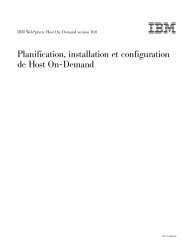Pianificazione, installazione e configurazione di Host On-Demand
Pianificazione, installazione e configurazione di Host On-Demand
Pianificazione, installazione e configurazione di Host On-Demand
You also want an ePaper? Increase the reach of your titles
YUMPU automatically turns print PDFs into web optimized ePapers that Google loves.
<strong>di</strong> specificare l’ubicazione del file HTML. Per ulteriori informazioni sullabase documento, consultare la sezione relativa alle impostazioni <strong>di</strong> avvioWeb nella guida online.Continuare con il passo 2.2. Selezionare Zip <strong>di</strong> emissione per salvare il file generato dal Wizard per la<strong>configurazione</strong> in un file Zip.3. Fare clic su Crea file.4. Creare una <strong>di</strong>rectory <strong>di</strong> pubblicazione utente separata,/<strong>di</strong>r_pubblicazione_utente/.5. Eseguire l’FTP del file ZIP <strong>di</strong> emissione nella <strong>di</strong>rectory <strong>di</strong> pubblicazioneutente, /user_publish_<strong>di</strong>r/.6. Utilizzare la funzione DWunzip per installare i file generati dal Wizard per la<strong>configurazione</strong> nella <strong>di</strong>rectory /<strong>di</strong>r_pubblicazione_utente/. Bisogna mo<strong>di</strong>ficareil file <strong>di</strong> coman<strong>di</strong> DWunzip sul server per specificare il corretto valoreMY_PUBLISHED_DIRECTORY. Consultare l’argomento della guida relativoall’Utilizzo <strong>di</strong> Dwunzip per ulteriori informazioni su come utilizzare questafunzione.I file HTML del Wizard per la <strong>configurazione</strong> sono installati nella <strong>di</strong>rectory/<strong>di</strong>r_pubblicazione_utente/. File aggiuntivi quali cfg0.cf e params.txt vengonoinstallati nella <strong>di</strong>rectory /<strong>di</strong>r_pubblicazione_utente/HODData/html_utente.7. Aggiungere una pass rule (nota anche come un alias su alcune piattaforme)nel file <strong>di</strong> <strong>configurazione</strong> del server Web in modo che punti a questa nuova<strong>di</strong>rectory <strong>di</strong> pubblicazione utente. Ad esempio, su IBM HTTP Server o ApacheHTTP Server, aggiungere quanto segue a /etc/httpd.conf:Pass /alias_utente/ * /<strong>di</strong>r_pubblicazione_utente/ *8. Se è necessario apportare delle mo<strong>di</strong>fiche nel file config.properties <strong>di</strong> <strong>Host</strong><strong>On</strong>-<strong>Demand</strong> (per mo<strong>di</strong>ficare ad esempio la porta predefinita o abilitare ilservlet <strong>di</strong> <strong>configurazione</strong> <strong>di</strong> <strong>Host</strong> <strong>On</strong>-<strong>Demand</strong>), procedere nel seguente modo:a. Aggiornare il file config.properties. Se la piattaforma server utilizzata nonsupporta il gruppo <strong>di</strong> caratteri ASCII, aggiornare questo file su unamacchina che supporta ASCII.b. Se il file config.properties è stato aggiornato su una piattaforma <strong>di</strong>versa daquella del server utilizzato, eseguire l’FTP del file sulla piattaforma serverutilizzata in formato binario.c. Memorizzare il file nella <strong>di</strong>rectory <strong>di</strong> pubblicazione utente,/user_publish_<strong>di</strong>r/.d. Aggiungere una pass rule (nota anche come un alias su alcunepiattaforme) nel file <strong>di</strong> <strong>configurazione</strong> del server Web. Ad esempio, su IBMHTTP Server o Apache HTTP Server, aggiungere quanto segue a/etc/httpd.conf:/alias_<strong>di</strong>r_pubblicazione_hod/config.properties/<strong>di</strong>r_pubblicazione_utente/config.propertiesSulla piattaforma zSeries, accodare l’estensione ascii, /user_publish_<strong>di</strong>r/config.properties.ascii.9. Se si sta utilizzando SSL e si ha bisogno <strong>di</strong> mo<strong>di</strong>ficare il fileCustomizedCAs.p12, procedere nel seguente modo:a. Memorizzare il file aggiornato nella <strong>di</strong>rectory <strong>di</strong> pubblicazione utente/user_publish_<strong>di</strong>r/CustomizedCAs.p12.80 IBM WebSphere <strong>Host</strong> <strong>On</strong>-<strong>Demand</strong> Versione 10.0: <strong>Pianificazione</strong>, <strong>installazione</strong> e <strong>configurazione</strong> <strong>di</strong> <strong>Host</strong> <strong>On</strong>-<strong>Demand</strong>






